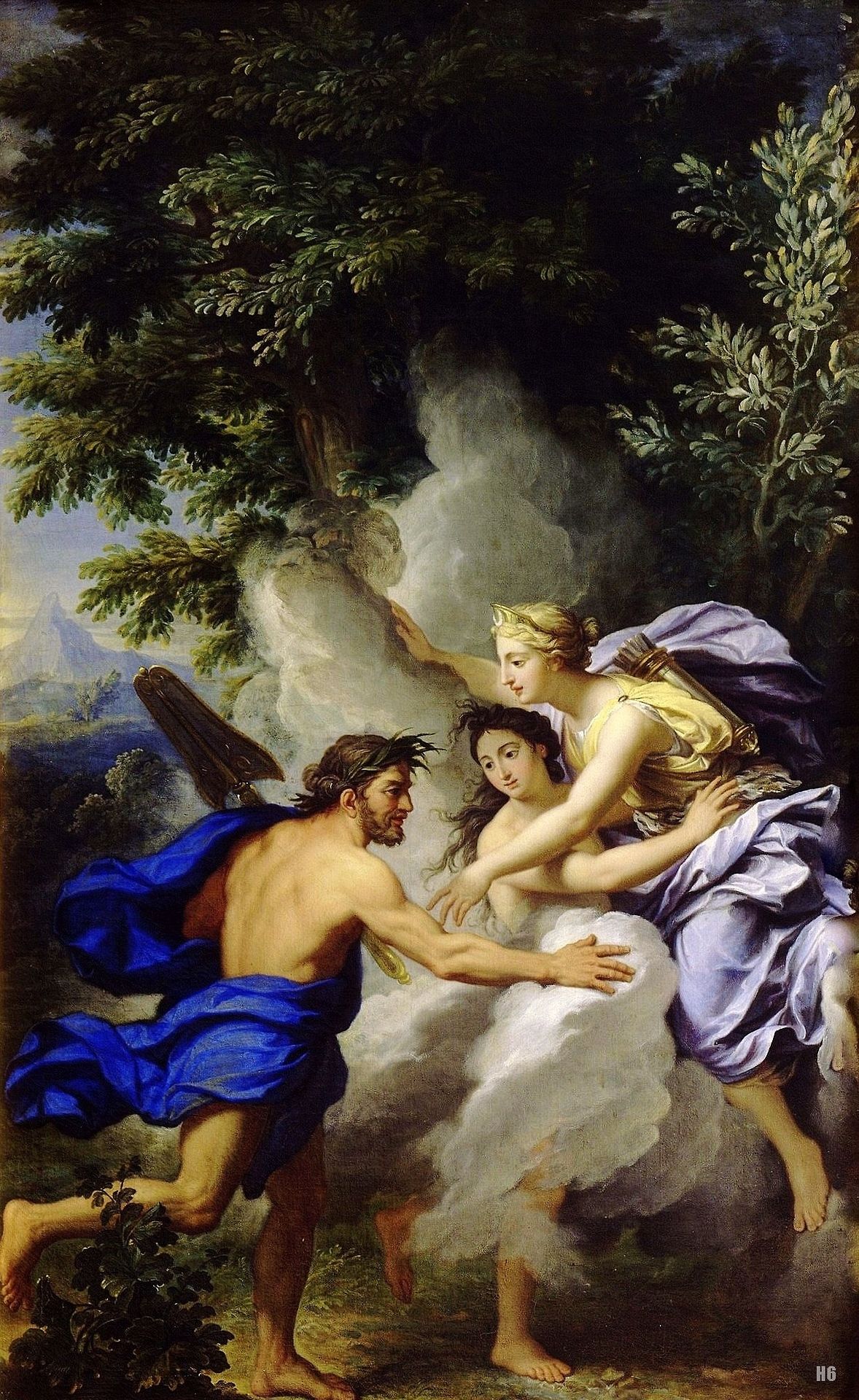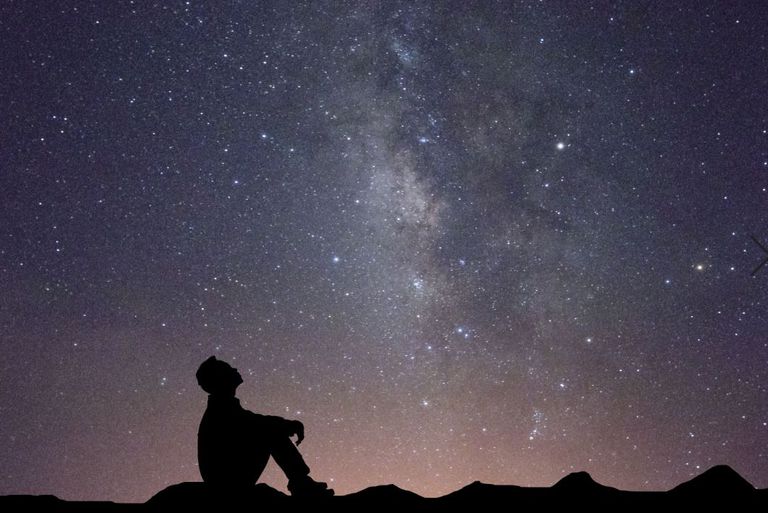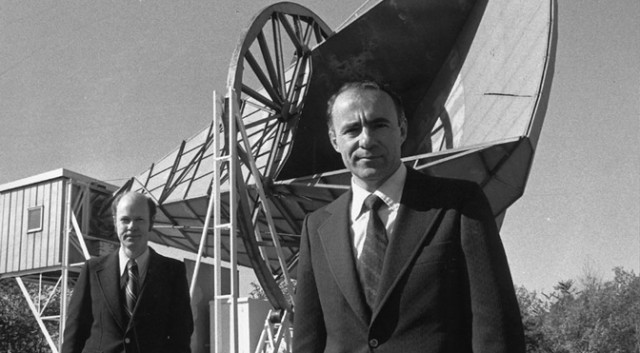
Alpheus and Arethusa: Mingling Waters
Arethusa, like 99.96% of the wood nymphs one encounters in the mythological realm, was enchantingly beautiful. By virtue of her appearance alone she could likely have captured any man she desired. However, having been a devoted follower of the virginal Artemis, she wanted none of them. Her only burning desire was to be a free spirit moving unconstrained through the forests, meadows and mountains in the company of her spiritual sisters. Arethusa knew that to yield to a man would be to accept the wearisome burdens of home and hearth and, most likely, to end up leading a life of miserable subjugation. So, each day Arethusa ran blissfully through the wilderness, secure in the belief that she was far from anyone who might try to ensnare her...or so she thought. Late one afternoon, Arethusa, fatigued by the day's exertions, disrobed and dove into a river. Elated by the cool, fresh water, Arethusa swam swiftly along the river current. At first she experienced a profound feeling of peace and contentment. Then, Arethusa sensed a motion in the water. As she swam to the bank, the nymph felt a hand reaching out to pull her down. She jumped out of the river and, while dressing, heard a deep voice say, "Why do you make such haste? Please remain." Arethusa said nothing as she began to run away. The voice called out, "I long for you to stay with me. You are such a beautiful maid." Arethusa shouted back, "And a maid shall I forever remain. Leave me be!" She soon realized that a man had emerged from the water and was pursuing her in great earnest. "I am Alpheus, the river god," he declared. "I love you dearly. Become my wife!" Arethusa ran all the more swiftly. "Never!"
Though Arethusa was faster than her purser, he was the stronger of the two and therefore would have been able to run her down over time. Arethusa reached the sea shore and while seeing Alpheus rushing toward her called out to her matron goddess to save her. Artemis answered her prayer by striking the sea with her arrow. The arrow formed a tunnel from the ocean to a remote spot on Ortygai, a lush Sicilian island. From this spot arose a sacred spring named Arethusa. Despite this transformation, Alpheus persisted in his pursuit. He turned himself back into a river and directed himself into the spring so that his waters and that of the spring would forever mingle. It was said that children used to toss fresh flowers into the Alpheus River in Greece just to watch them quickly sink out of the sight. They all knew -or at least believed- that those same flowers would quickly rise out of the spring on the distant island of Ortygai.
THE SOUTHWORTH PLANETARIUM
207-780-4249 www.usm.maine.edu/planet
70 Falmouth Street Portland, Maine 04103
43.6667° N 70.2667° W
Altitude: 10 feet below sea level
Founded January 1970
Julian Date: 24591166.16
2020-2021: XLIII
Let's begin here today:

Precisely. We're simply looking into the night sky. After all, it was by this ancient practice that astronomy was born. Through time our admiration and reverence evolved into observation and inquiry. Somehow, despite our confinement on this minuscule planet, humans have managed to learn much about how the Universe began and developed. How did astronomers discover what transpired billions of years before Earth even formed?
Remarkably, the first clue was the night sky, itself. German astronomer Heinrich Wilhelm Olbers (1758–1840) presented a question that has since become known as the famous Olber's Paradox. "If the Universe is infinite and contains an infinite number of stars, how can the night sky be dark?" He reasoned that our sky should be uniformly bright because each point on the sky should be illuminated by one of those stars. The night sky's darkness led astronomers to conclude that the Universe was not of infinite extent and did not contain an infinite collection of stars.
The notion that the Universe could have had a beginning, though, did not come into vogue until the 20th century. First, Einstein's Theory of General Relativity predicted that the cosmos would constantly expand. As astronomers had not yet collected any evidence suggestive of this expansion, Einstein included a "fudge factor" called the cosmological constant. This constant counteracted this expansion so that Einstein's cosmic model was more aligned with what was then the accepted view of a static Universe.
In 1912, astronomer Vesto Slipher observed that the spiral nebulae, then believed by many astronomers to have been contained within the Milky Way Galaxy, seemed to be receding away from our solar system. This announcement was not regarded as vitally important at the time, as astronomers hadn't yet determined that the Universe extended beyond our home galaxy. Also, most scientists subscribed to the "Steady State Theory" that posited that the Universe was static and did not have a specific beginning.
In 1924, American astronomer Edwin Hubble determined that the Andromeda Nebula, now known as the Andromeda Galaxy, was located outside the Milky Way's boundary. This discovery dispelled any notion that our galaxy encompassed the entire cosmos. Many galaxies were soon thereafter discovered well beyond the Milky Way's bounds.
In 1929, American astronomer Edwin Hubble announced that most galaxies were moving away from our own. Moreover, he found that the more distant galaxies were receding faster from us than the closer ones. After this announcement, the Universe was no longer regarded as static. Einstein then declared that the inclusion of the cosmological constant was the "greatest blunder of my life."
The outward galactic motions implied that some event had to have preceded a Universal expansion. Belgian priest and physicist Georges Lemaître (1894-1961) proposed a theory that its principal detractor, the eminent British astronomer and ardent steady state proponent Fred Hoyle (1915-2001), mockingly called "The Big Bang." Lemaître proposed that at one time all the material comprising the Universe began as a super atom that exploded and then expanded. This expansion continues today.
Georges
Lemaître (1894-1961), the Belgian Priest/Physicist who first developed the Universal creation theory now known as the Big Bang.
Many of Lemaître's astronomical contemporaries balked at the proposal that time began at a specific moment. The notion seemed more in line with theological belief that scientific reality: something that a priest would obviously propose.
For the next few decades, the scientific community was divided between the Big Bang Theory and the Steady State Theory, the latter of which asserted that new matter was created as the Universe expanded, thereby sustaining an infintely-old Universe.
The balance shifted in favor of the Big Bang Theory in 1964, when physicist Arno Allan Penzias and radio astronomer Robert Woodrow Wilson discovered the pervasive "static hiss" indicative of the Cosmic Microwave Background Radiation through their radio antennae. This hiss, which they discovered inadvertently while testing their antennae, was thereafter dubbed "the Big Bang's Echo." As the Universe expanded and cooled, the radiation pervading it -which, we recall from Monday's RP was once trillions of degrees hot- was reduced to less than 3 Kelvin, or three degrees above absolute zero.

Penzias and Wilson The first to hear the Big Bang's "echo." Physicist Arno Allan Penzias and radio astronomer Robert Woodrow Wilson discovered the pervasive "static hiss" indicative of the Cosmic Microwave Background Radiation through their radio antennae. These scientists received the 1978 Nobel Prize in Physics for this discovery.
The detection of the Cosmic Microwave Background radiation signature was the death knell for the Steady State Theory. The Big Bang became -and remains- the origin theory that nearly all cosmologists now accept.
On Monday, we'll delve into the Universe's possible fate with a discussion about Dark Energy.
Want more information about the Big Bang?
We recommend:
Big Bang: The Origin of the Universe
Simon Singh
A Brief History of Time
Stephen Hawking
Stephen Hawking
To subscribe or unsubscribe from the Daily Astronomer: